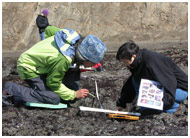Welcome to our ongoing effort to catalog citizen science and other public participation in scientific research (PPSR) projects for UC California Naturalists and other citizen scientists. We invite you to browse the listed projects or enter key words (like birds, youth, invasive, coast, Alameda, etc.) in the search box above to find projects in your area. It's a great way to stay involved and keep developing your skills as a natural scientist!
A vast majority of the information in the database was gathered from project websites and may be out of date. We encourage you to contact projects directly to get involved and learn about most recent opportunities. If you work with a listed project and would like to add to, update, or correct the information we have, please email cghdixon@ucdavis.edu. Also, please consider filling out the "PPSR perspectives" survey. Click here to access the survey, which will help guide this project in the coming year.
If you know of a project not on our list, please go to the "tell us about a project" link on the left so we can list the project here. Thanks for your help!
Special thanks goes to the National Science Foundation Informal Science Education program and the Stephen J. Bechtel, Jr. Foundation for supporting this database of projects.
Rocky Intertidal Monitoring Project
-
Organization NameLiMPETS (Long-term Monitoring Program and Experiential Training for Students)
-
Project Website
-
Organization Website
-
PartnersCalifornia’s National Marine Sanctuaries, Farallones Marine Sanctuary Association, Marine Science Institute at UC Santa Barbara, Pacific Grove Museum of Natural History
-
Contact NameN / A
-
Contact EmailN / A
-
Contact PhoneN / A
-
Other Contact Information
Since there multiple National Marine Sanctuary's go to this website to find the appropriate contact person. http://limpetsmonitoring.org/contact.php
-
Project Purpose (taken from project materials)
Collect baseline data on intertidal zone condition in order to follow changes over time and better understand impacts of human activities and climate change; provide students with the opportunity to experience the scientific process firsthand; increase awareness and stewardship of National Marine Sanctuaries.
-
Participant Activities
Participants will identify algae and invertebrates and practice the monitoring methods used in the field. Measurement of size and number of various invertebrates and types of algae will be taken. Other methods used include: Vertical transect, random quadrant, total counts.
After data is collected, participants enter data online.
Participants also work in classes or groups to develop research questions and use the online graphing tools to analyze results.
-
Data Entry
-
Website
-
Collection Kits
-
Data Sheets
-
-
Other Participant Activities
Some participants attend scientific meetings, others create informational kiosks or lead community tidepool walks; Workshops for teachers.
-
System Studied
-
Invertebrates
-
Climate Change
-
Intertidal zone
-
Other (see Notes)
-
-
Geographic ScopeRegional
-
RegionNorthern California
-
LocationMultiple sites along the Northern California coast
-
Location - MapMonterey Bay, Gulf of the Farallones and Channel Islands
-
Time Commitment
-
Other (see Other Information below)
-
-
Volunteer Qualifications
Most participants are of High School age and have an adult group leader.
There are some tools involved. These can be purchased for about $250 or in most cases you can make your own. Also, some may be borrowed from the LiMPETS coordinator.
Before beginning monitoring:
- Training: Teachers or group leaders complete a training by the local LiMPETS coordinator.
- Preparation: Everyone should learn to correctly identify algae and invertebrates and practice the monitoring methods used in the field.
- Monitoring: It is recommend that you explore your monitoring site and practice the monitoring techniques at least once before monitoring begins.
-
Volunteer Training
Training: Teachers or group leaders complete a training by the local LiMPETS coordinator. You must contact the local coordinator for dates and times of training.
-
Cost to Participant
There are minimal fees for training of leaders.
Time Commitment: A significant commitment by the teacher or adult leader is necessary to coordinate this project. Preparation is key! Learning to correctly identify rocky intertidal algae and invertebrates can take time, but for the science geeks in your group, this is the best part. -
How will the findings be used?
Participants will be able to view data online through the LiMPETS online database. It is also available to the general public to view as well.
Trend analysis is the most obvious use of the data.
Sharing your results is important too! Some participants attend scientific meetings, others create informational kiosks.
-
Other Information
The LiMPETS network is a collaborative effort among California’s National Marine Sanctuaries, Farallones Marine Sanctuary Association, Marine Science Institute at the University of California at Santa Barbara, and the Pacific Grove Museum of Natural History.
-
Photo

-
last update:N / A
If you work with this project and would like to add to or update the information below, please email cghdixon@ucdavis.edu.
If you know of a project not on our list, please go to the "tell us about a project" link on the left so we can list the project here. Thanks for your help!
This database is focused on projects in California focused on the environment. For opportunities outside California, as well as national projects that don't have a California-specific components, check http://www.birds.cornell.edu/citscitoolkit/projects.

